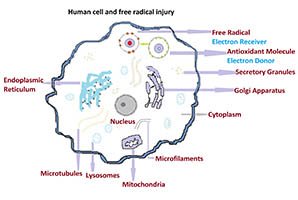What are Free-radicals? How are they harmful to humans?
Scientists think that the generation of free radicals inside a cell is the triggering factor for disease processes in humans.
What are these Free radicals?
 |
| Human cell and mechanism of free radicals injury. |
Free radicals are unstable, free molecules of reactive oxygen species and reactive nitrogen species generated inside the human body. They are labeled as incomplete atoms in the sense that they lack an electron attaching to them.
Since they are unstable and freely wander inside the cells, they react quickly with other components in their vicinity in order to capture "the" required electron to form a pair and become stable. This inclination and reaction of free radicals with different organelles inside a living cell lead to their structural damage.
Once the rate of injury supersedes repair, the disease process ensues in the form of depressed immunity, easy susceptibility to viruses and bacteria, cancers, cardiovascular diseases, nerve degeneration, etc.
Types of Free radicals
Broadly, free radicals are grouped into two broad categories; Reactive oxygen species (ROS) and reactive nitrogen species (RNS). Reactive oxygen species comprises peroxides, hydroxyl radical, superoxide, oxybenzone, and hypochlorous molecules.
Reactive Nitrogen species include nitric oxide, peroxynitrite, etc. Reactive oxygen species so far are the most powerful free radicals that directly attack cellular structures and DNA.
What triggers free radical production? The sources of free radicals.
In living organisms, different kinds of free radicals are produced continuously and spontaneously inside all the metabolically active cells. In fact, free radicals are the resulting end products in response to active enzymatic cellular metabolism.
They are regularly created inside lysosomes, mitochondria, peroxisomes, and other enzymatically dynamic structures inside the cells. Reactive oxygen species are led by hydroxyl radicals, the most powerful endogenous oxidants.
Apart from natural oxidants produced inside the body, a plethora of exogenous agents initiate a cascade of oxidation reactions upon gaining entry into the human body and coming in contact with tissue cells.
Any sources could trigger free radical formation. such as solar radiation, air pollutants such as carbon monoxide, ozone, tobacco smoke, benzene, chlorine, formaldehyde toluene, exposure to ionizing radiation, consumption of medicines, heavy metals in food and water, Inhalation of chemical solvents such as cleaning products, paints, cosmetics, perfumes, pesticides, processed foods containing artificial flavorings, food color agents, trans fats, high levels of lipid peroxides, etc.
Firstly, these free radicals are generated when the human body is exposed to various stress conditions, which result in the splitting up of a water molecule into Hydroxyl and hydrogen ions.
H2O= OH+ + H+ This OH+ (Hydroxyl) molecule is the most powerful of ROS.
Role of free radicals in human diseases
Inside the human cells, there is an effective antioxidant defense system to counter the damaging actions of reactive oxygen species. Oxidative stress happens whenever free radicals take the upper hand and shift the tide on their side, resulting in excessive and uncontrolled distress in cellular homeostasis. Most cells can withstand this damage to a limited extent by recognizing and removing oxidatively damaged particles and repairing the structures. Free radicals attack all the main cellular components.
The extent of tissue damage depends on the type of reactive species involved. Extensive damage can lead to the death of the cell and part or whole of the tissue. Peroxidation of lipids in cell membranes can cause the collapse of cell membranes and alter the function of membrane-bound proteins such as enzymes and receptors. Direct damage to structural proteins and DNA inside the cells may result in loss of cell architecture and lack of its ability to restore.
What diseases do free radicals cause in humans?
Oxidative damage to various structural components inside the cell is the most common reason that leads to the development of different disease manifestations in humans. The direct attack on chromosomes and the DNA can cause a mutation, which, when continuing unregulated, may lead to the development of cancers.
Further, endothelial damage inside the vessels can cause atherosclerosis, vascular blockage, loss of vessel integrity, bleeding, etc., and can cause various cardiovascular diseases. Free radicals have also been attributed to cataracts, Alzheimer's disease, neurodegenerative diseases, kidney tubular dysfunction, connective tissue diseases, age-related eye disease, etc.
Role of antioxidants in the prevention of Oxidant stress.
While ROS continuously attacks cell components, numerous natural and synthetic antioxidants engage in taming the oxidant fury by donating an electron and trapping them thereby rescuing organelles and DNA.
Antioxidant enzymes like catalase, glutathione peroxidase, superoxide dismutase, etc., participate in the repair of structural components and restoration of cellular function in the aftermath of oxidant stress. Several important vitamins like vitamins A, E, and C, and beta-carotene act as direct antioxidants. Vitamin- C works at aqueous levels inside the cell.
≻≻-Back to Articles on nutrition from Free radicals.
≻≻-Back to Home page.